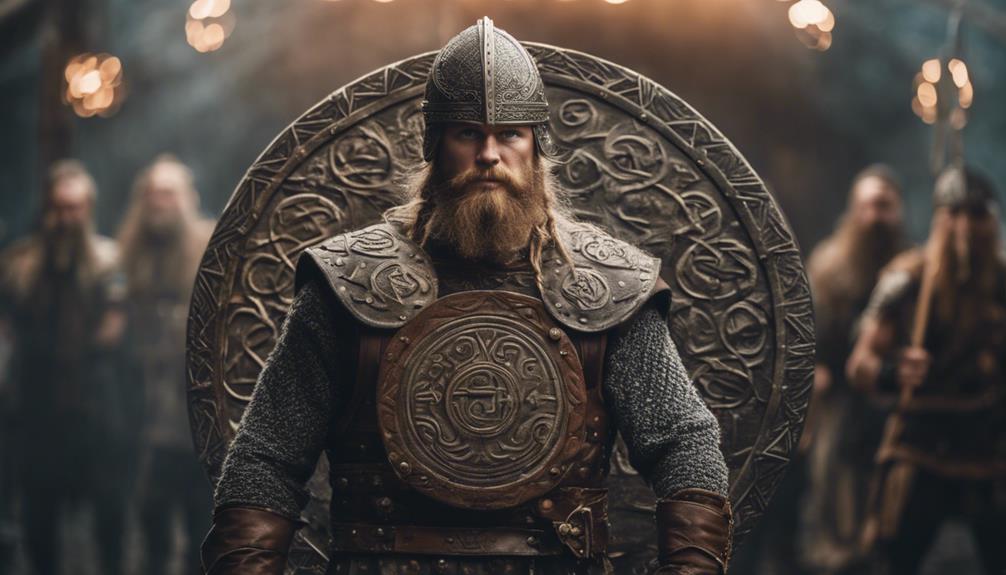Viking warrior symbols hold deep meanings. Thor’s Hammer shows **protection**, **strength**, and divine favor in battles. The Valknut highlights the links between life, death, and the gods. The Helm of Awe scares enemies and boosts protective power. The Viking Compass guides travelers through wild seas, marking finding direction in tough times. Yggdrasil, the Tree of Life, stands for cosmic balance and the cycle of life, death, and rebirth. Each symbol mirrors ancient Norse values and beliefs, offering a peek into a rich history. Knowing these symbols unlocks the warrior’s spirit and mythological world of the Vikings.
Key Takeaways
- Thor's Hammer signifies divine favor, strength, and luck in battle.
- Valknut symbolizes interconnectedness, life, death, and divine influence.
- Helm of Awe provides protective power, courage, and resilience in battles.
- Viking Compass guides and protects travelers in uncertain situations.
- Tree of Life represents cosmic balance, wisdom, and the cycle of life.
Thor's Hammer Symbol Meaning
Thor's Hammer, known as Mjölnir, embodies protection, strength, and luck in battle for Viking warriors. This symbol, wielded by the mighty Norse god Thor, holds great significance in Viking culture. It isn't merely a tool of war but a representation of safety and divine favor on the battlefield. Vikings believed that wearing Mjölnir wouldn't only shield them from harm but also amplify their physical prowess, granting them an edge in combat.
The intricate design of Mjölnir mirrors its role as a symbol of power and divine influence in Norse mythology. Its presence around a warrior's neck signified readiness for battle, instilling confidence and a sense of invincibility. The belief in Mjölnir's protective qualities was so strong that Vikings trusted in its ability to guide them safely through the chaos of warfare. Therefore, Thor's Hammer became an emblem of courage and strength, ensuring that its bearer faced battles with luck on their side.
Valknut Symbol Interpretation
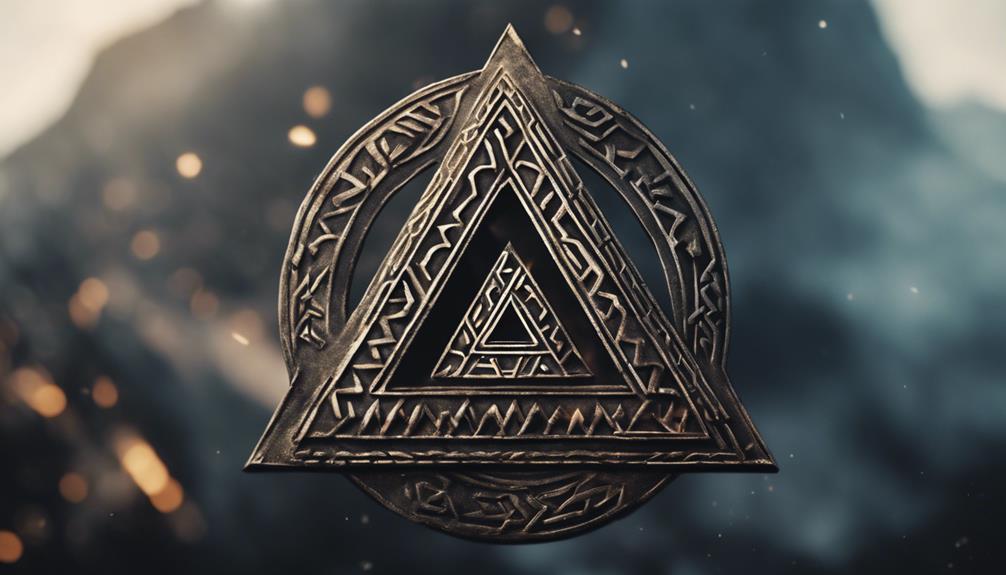
The Valknut symbol, also known as the Knot of the Slain, holds significant meaning in Norse mythology. It's closely associated with Odin, emphasizing his connection to slain warriors and the afterlife.
The intertwining triangles and nine corners of the Valknut represent the intricate relationship between life, death, and the divine in Viking culture.
Knot of the Slain
Interwoven with mystic significance and intricate symbolism, the Valknut symbol, also known as Odin's Knot, is a powerful emblem in Viking culture representing the interconnectedness of life and death.
Consisting of three interlocking triangles with nine corners, it symbolizes the nine worlds of Norse mythology. Found in Viking tombs alongside figurines associated with Odin, the Valknut signifies slain warriors and the cycle of life.
This symbol also embodies themes of pregnancy and motherhood in the Norse universe. As Odin welcomed heroes to Valhalla, the Valknut became a symbol of his favor and connection to warriors.
Its deep symbolism and intricate design make it a revered symbol in Viking culture, symbolizing heroism and fate.
Odin's Connection
Associated with Odin, the Valknut symbol is a powerful representation of the interconnectedness of life and death in Viking culture. This symbol, featuring three interlocking triangles, signifies the slain warriors chosen to reside in Valhalla according to Norse mythology. It embodies the cyclical nature of existence, emphasizing the shifts between death and rebirth.
Often found in Viking tombs alongside Odin-related figurines, the Valknut also symbolizes themes of pregnancy and motherhood. Odin's connection to the Valknut underscores his role in welcoming fallen heroes to Valhalla, showcasing his importance in the afterlife of warriors. This symbol serves as a reminder of the eternal cycle of life, death, and renewal that was central to Viking beliefs.
Helm of Awe Symbol Significance

The Helm of Awe, also known as Aegishjalmur, holds significant protective power in battles, instilling fear in enemies and offering defense to warriors.
Believed to provide strength and command to the wearer, this symbol symbolizes courage, resilience, and divine protection in Norse mythology.
Warriors adorned with the Helm of Awe were thought to be shielded from harm and empowered in combat, reflecting the Vikings' belief in the supernatural and their connection to ancient gods.
Protective Power in Battles
Crafted with intricate detail, the Helm of Awe symbolizes protection and instills fear in enemies on the battlefield, empowering warriors with a sense of invincibility. Vikings believed this symbol created a protective barrier around them, invoking confidence and strength. The Aegishjalmur was not only a source of courage but also commanded respect and offered divine safeguarding. Warriors adorned with this symbol sought its mystical powers, believing it would guide them through the chaos of warfare. The Helm of Awe served as a powerful amulet, instilling a deep sense of security and fortitude in those who wore it. Below is a table summarizing the key aspects of the protective power associated with the Helm of Awe:
| Aspect | Description |
|---|---|
| Protection | Creates a barrier around the wearer |
| Fear | Instills fear in enemies |
| Confidence | Empowers warriors with invincibility |
Fear-Inducing Warrior Defense
Embodying the essence of fear and protection, the Helm of Awe symbol stands as a formidable defense for Viking warriors in the heat of battle. Also known as Aegishjalmur, this Norse symbol instills fear in enemies and offers essential protection to those who wear it.
It creates a sphere of intimidation around the wearer, enhancing their courage and strength in combat. Crafted with intricate detail, the Helm of Awe symbolizes command and prowess, believed to possess mystical protective properties.
This symbol played a significant role in inspiring Viking warriors, rallying them together for battle with a sense of invincibility. In the midst of conflict, the Helm of Awe served as a potent emblem of defense and intimidation, empowering warriors to face their foes with unwavering bravery.
Viking Compass Symbol Explained

Exploring perilous waters and uncharted lands, the Viking Compass symbol, Vegvisir, serves as a beacon of guidance and protection for travelers. Depicted as a magical stave or runic compass, Vegvisir aids in charting rough seas and unknown territories. Believed to prevent individuals from losing their way, this symbol guarantees finding the right path even in challenging conditions. Vikings heavily relied on Vegvisir to steer them safely back home or to their desired destinations during their voyages.
The Viking Compass symbolizes the importance of finding direction and protection amidst uncertainty and adversity. It embodies the idea of staying on course and being shielded from harm while journeying through life's unpredictable challenges. Vegvisir acts as a reassuring emblem, reminding travelers to stay determined and focused, even in the face of difficulties. This ancient symbol continues to inspire individuals to seek guidance and safeguard their path in times of need.
Tree of Life Symbol Representation

The Tree of Life, known as Yggdrasil in Norse mythology, holds deep symbolic roots and origins that signify the interconnectedness of all life.
Its spiritual connection significance is seen in how it supports and connects the nine worlds of Norse cosmology.
Today, cultural interpretations of the Tree of Life continue to evoke the cycle of life, death, and rebirth, resonating with the eternal and cyclical nature of existence.
Symbolic Roots and Origins
Symbolizing interconnectedness and cosmic balance, the Tree of Life symbol, known as Yggdrasil in Norse mythology, holds profound significance in Viking culture.
Yggdrasil represents the cycle of life, death, and rebirth, embodying the eternal wisdom and interconnected nature of the universe. Its roots penetrate into different domains, interconnecting the nine worlds of Norse mythology.
In Viking beliefs, Yggdrasil symbolizes divine order, cosmic balance, and the continuous cycle of creation. The Tree of Life is a powerful symbol of fate and wisdom, illustrating the enduring connection between all things in the cosmos.
Through Yggdrasil, the Vikings found a representation of the interconnected web of life and the ever-present balance that governs the universe.
Spiritual Connection Significance
Representing the deep spiritual connection between all life forms and the cosmos, the Tree of Life symbol, Yggdrasil, holds profound significance in Norse mythology and Viking culture. Yggdrasil symbolizes the interconnectedness, cycle of life, and wisdom in Norse cosmology. It embodies balance and the divine order, emphasizing the eternal nature of existence. The branches of Yggdrasil stretch to the nine worlds, symbolizing the link between all aspects of life. This cosmic tree serves as a powerful metaphor for existence, highlighting the spiritual connection between all beings. In Viking beliefs, the Tree of Life signifies continuity and the harmonious relationship between the physical and spiritual worlds.
| Yggdrasil Symbolism |
|---|
| Interconnectedness |
| Cycle of Life |
| Norse Cosmology |
| Wisdom |
| Spiritual Connection |
Cultural Interpretations Today
Today, the Tree of Life symbol from Norse mythology continues to hold cultural significance, reflecting interconnectedness and spiritual unity across diverse communities. Known as Yggdrasil in Norse cosmology, this symbol represents the cosmic order and the interconnected nature of life.
In Viking culture, the Tree of Life embodies the cycle of existence, symbolizing life, death, and rebirth. It's a powerful representation of divine wisdom, fate, and the eternal cycle of creation and destruction.
The Tree of Life symbolizes the interconnectedness of all living beings and the cyclical nature of existence in Norse beliefs. Its enduring presence in modern culture serves as a reminder of the profound connection between all things and the eternal cycle of life.
Triple Horn of Odin Meaning
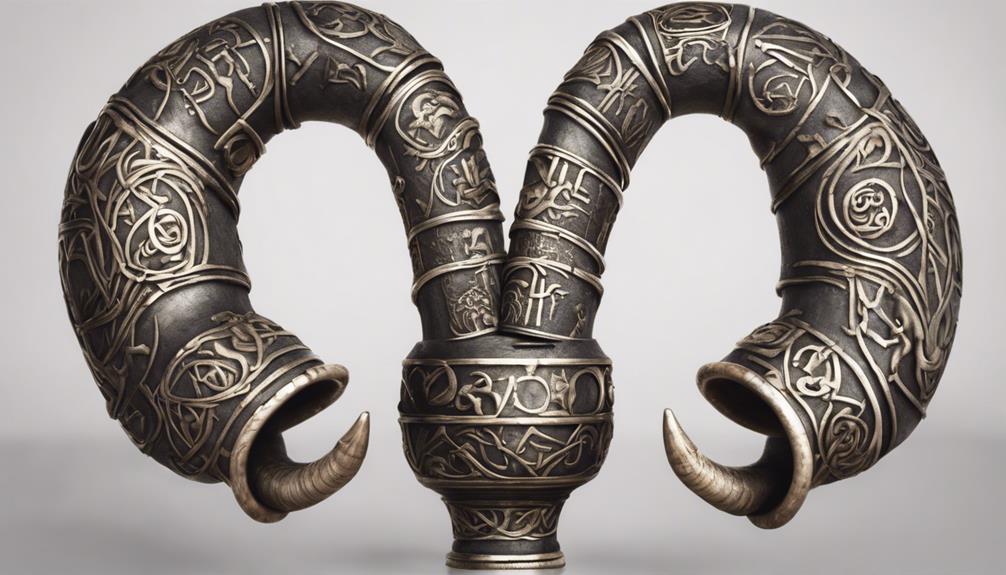
The Triple Horn of Odin in Norse mythology embodies wisdom, inspiration, and poetic creativity. It consists of three interlocking drinking horns symbolizing the mead of poetry, a source of divine inspiration.
Associated with Odin, the Allfather, this symbol represents his relentless pursuit of knowledge and enlightenment. Those who wear or display the Triple Horn of Odin seek wisdom, artistic inspiration, and spiritual guidance in their lives. It serves as a powerful reminder of the importance of seeking wisdom and the pursuit of knowledge.
This symbol is a potent talisman for individuals desiring to channel their inner creativity and connect with higher sources of inspiration. The Triple Horn of Odin is deeply rooted in Norse mythology, carrying with it centuries of symbolism and significance passed down through generations.
Embracing this symbol means embracing the quest for wisdom and the power of poetic expression in one's life.
Tribal Viking Axe Symbolism
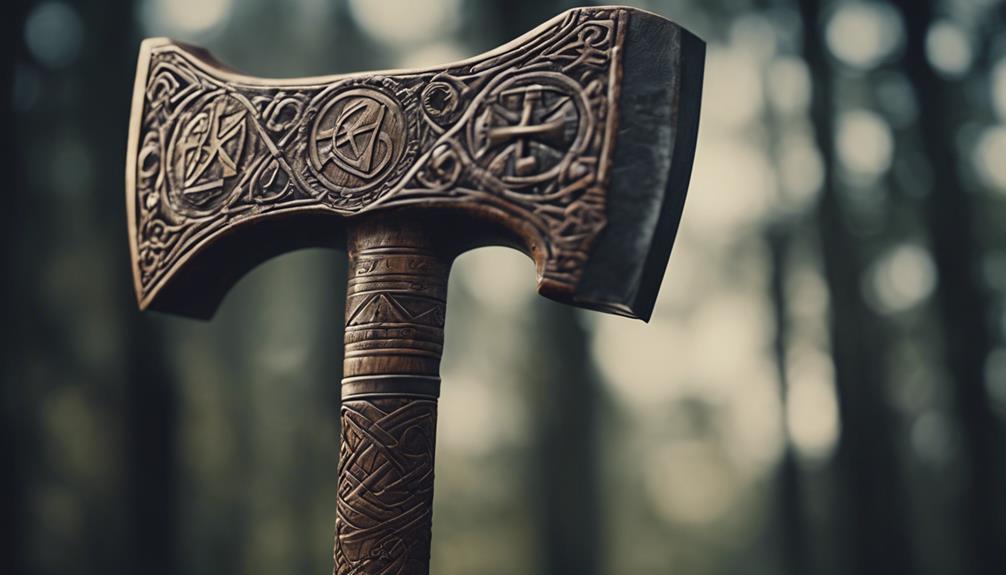
Symbolizing strength, courage, and ferocity in battle, the Tribal Viking Axe holds profound significance in Norse warrior culture. Vikings revered the axe as a symbol of power and prowess, essential for their success in combat.
These axe symbols were meticulously crafted, showcasing the warrior's prestige and expertise. Serving both offensive and defensive purposes, the Viking axe represented protection on the battlefield. It stood as a proof to the warrior's preparedness for conflict and unwavering dedication to achieving victory.
The intricate designs of these axes reflected not only the physical strength of the wielder but also their mental fortitude and fearlessness in the face of danger. For Vikings, the axe was more than just a weapon; it embodied the very essence of their warrior spirit – a potent blend of resilience, aggression, and the relentless pursuit of triumph in battle.
Yggdrasil Symbol of Life

Norse mythology's revered Yggdrasil, symbolizing the interconnectedness of life, death, and rebirth, embodies cosmic order and wisdom in Viking culture. This Tree of Life is central in Norse cosmology, linking the nine worlds of the Norse universe. Its roots extend into different domains, while its branches soar towards the heavens, symbolizing the connection between worlds. Yggdrasil serves as a powerful representation of life's cyclical nature and the eternal cycle of existence according to Viking beliefs. The tree signifies continuity and the flow of life, reflecting the profound wisdom and cosmic order cherished by the Vikings.
| Yggdrasil Symbol of Life | ||
|---|---|---|
| Interconnectedness | Norse mythology | Cosmic order |
| Continuity | Wisdom | Nine worlds |
| Cyclical nature |
Gungnir Odins Magical Spear
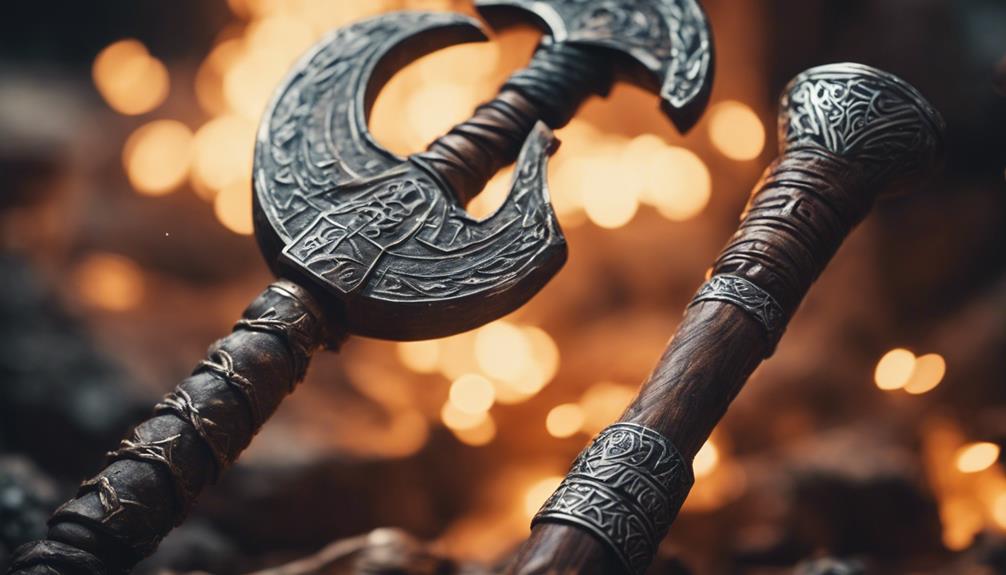
Crafted by skilled dwarves in Norse mythology, Gungnir symbolizes inspiration, courage, strength, and wisdom for Odin. This magical spear, imbued with mystical powers, is a significant emblem of Odin's authority and prowess in battles.
Here are three key points about Gungnir:
- Unwavering Precision: Gungnir, the spear of Odin, possesses the remarkable ability to unfailingly hit its mark and then return to Odin's hand, showcasing its supernatural qualities.
- Symbol of Victory: In Norse mythology, Gungnir isn't only a weapon of physical strength but also a symbol of Odin's leadership and guidance, leading warriors to triumph on the battlefield.
- Divine Wisdom: Beyond its role in warfare, Gungnir embodies divine wisdom and the concept of fate in Norse culture, emphasizing Odin's deep understanding of the world and the future.
Through Gungnir, Odin's magical spear, the Norse mythos encapsulates the essence of inspiration, courage, strength, wisdom, and authority.
Eight-Legged Horse Symbolism

Odin's connection to the spiritual world is further exemplified through Sleipnir, his divine eight-legged horse symbolizing speed, luck, and transcendence in Viking culture. Sleipnir, the steed that carries Odin across the cosmos, embodies strength and agility. Its eight legs represent the ability to traverse different domains, emphasizing Odin's power, wisdom, and spiritual connection.
In Norse mythology, Sleipnir is a mystical creature symbolizing the Allfather's capacity to move swiftly and navigate various dimensions. The symbolism of speed associated with Sleipnir highlights the quick and decisive nature of Odin's actions. Additionally, the luck represented by Sleipnir underscores Odin's favor in battles and endeavors. The concept of transcendence linked to Sleipnir signifies Odin's ability to transcend physical limitations and access higher planes of knowledge and understanding.
Through Sleipnir, Odin's prowess, insight, and divine influence are magnified, making the eight-legged horse a potent symbol of the Viking god's multifaceted nature.
Frequently Asked Questions
What Is the Viking Symbol for Warrior?
The Viking symbol for a warrior is the Valknut, representing slain warriors and the cycle of life. Warriors wore it for Odin's protection in battle. Its three interlocking triangles with nine corners symbolize the interconnectedness of the nine worlds in Norse mythology.
Found in Viking tombs, it signifies the importance of warrior culture and beliefs about the afterlife. The Valknut also symbolizes courage, bravery, and the eternal bond between fallen warriors.
What Is the Most Powerful Viking Symbol?
The most powerful Viking symbol is Mjölnir, Thor's hammer, representing protection, strength, and luck. It was believed to bless marriages, protect gods, and serve as a talisman in battle. Mjölnir embodied safety and symbolized divine protection and authority in Viking culture.
Thor's hammer remains a revered emblem of strength and protection in Norse mythology, transcending mere symbolism to embody potent warrior attributes.
What Viking Symbol Is Guidance?
The Viking symbol of guidance is known as the Vegvisir, symbolizing the importance of finding one's path and staying on course amidst challenges and uncertainties.
Represented as a compass-like symbol with runic characters, the Vegvisir was believed to guide and protect travelers, ensuring they reach their destination safely.
Vikings relied on this symbol to navigate through unknown territories and seek guidance in times of need, especially during sea voyages.
What Is the Viking Guide Symbol?
The Viking guide symbol, known as Vegvisir, offers guidance and protection during journeys, particularly at sea. It resembles a compass and aids travelers in finding their way and avoiding getting lost.
Vegvisir is linked to Norse mythology, providing spiritual guidance and ensuring safe travels for those who carry or use it. This intricately designed symbol serves as a powerful talisman for individuals seeking direction and safety in their adventures.
What is the significance of Viking symbols in relation to the meanings of the Thoth Tarot deck?
Viking symbols hold great significance in relation to the meanings of the Thoth Tarot deck. These ancient symbols connect to the wisdom and deep understanding found within the Thoth Tarot, making it essential for beginners grappling with the complexities of the deck. A beginner’s guide to Thoth Tarot can help navigate this rich symbolism.
Conclusion
To sum up, Viking symbols hold deep meanings that reflect the warrior spirit and beliefs of the ancient Norse people. From Thor's Hammer symbolizing protection to the Valknut representing the connection between life and death, each symbol tells a story of strength and power.
So next time you see these symbols, remember that they're more than just images – they're a window into the rich history and culture of the Viking warriors. Let these symbols guide you on your own journey of discovery and adventure.

